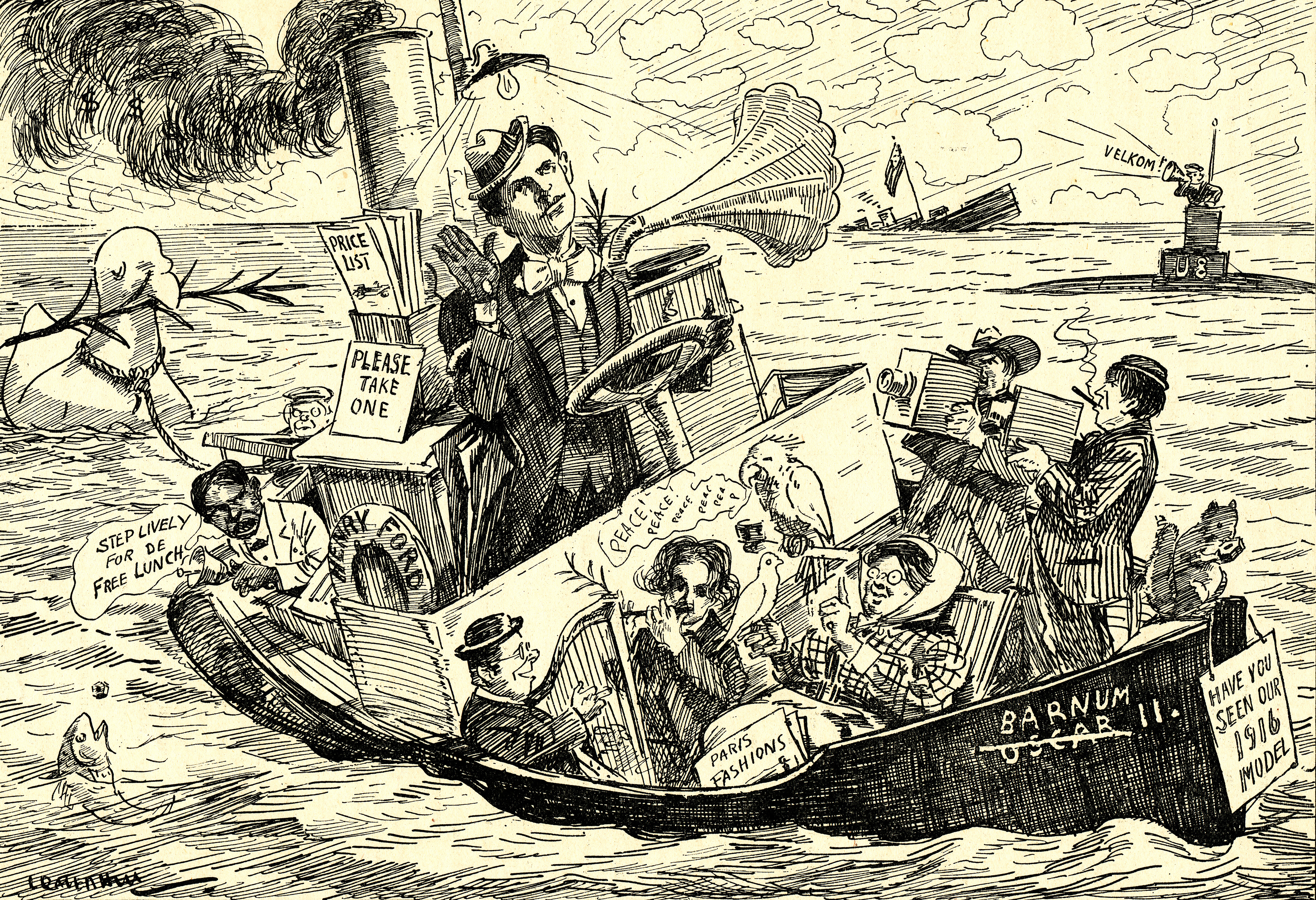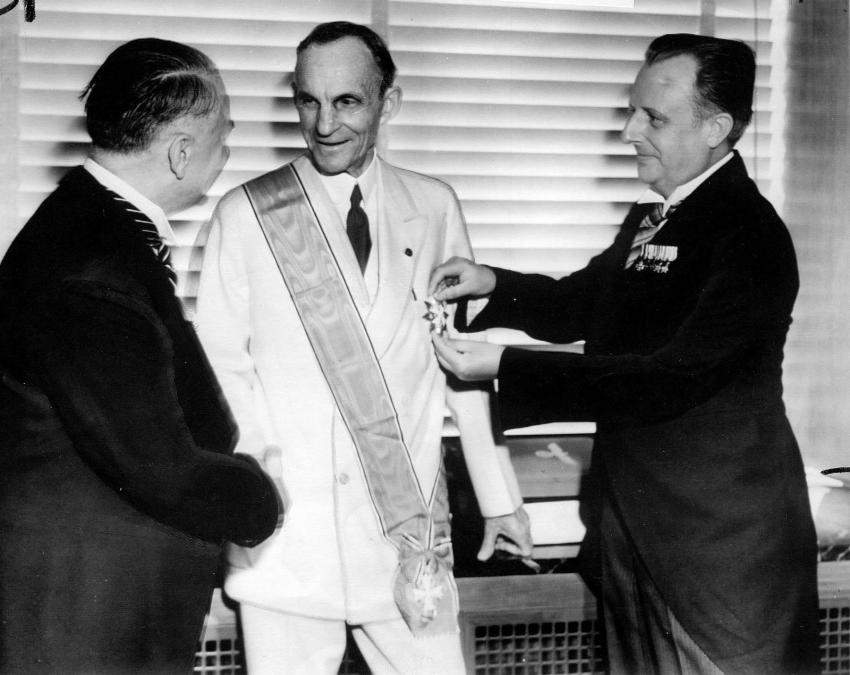Henry Ford was a leading industrialist throughout the early 1900s and created the first mass produced automobiles. Ford held many strong convictions on religion, history, politics, war and the issue of the Jews during World War II. These convictions led him to oppose both World Wars at their outbreak in line with his general pacifism, but he then eventually stood behind his own country as the United States entered the wars.
Born July 30, 1863 to William and Mary Ford in Greenfield Township, Michigan, Henry Ford grew up with four younger siblings: Margaret, Jane, William and Robert. Henry’s parents were farmers, though Henry had a distaste for farm work which led him to move to Detroit and become a machinist apprentice for multiple companies [6]. In 1891, Ford began working for the Edison Illuminating Company where he was an engineer. He quickly moved through the ranks to become a chief engineer which afforded him the ability to pursue his own projects. On June 4, 1896, Henry test drove Quadricycle, his very first car [8]. Thomas Edison, who was a close friend of Ford, encouraged Henry to develop his car further and this culminated in the creation of the Ford Motor Company in 1903.
World War One and the Peace Ship

Ford was so opposed to the war that he even financed a diplomatic mission to Europe in order to try to facilitate peace between the nations. In 1915, the Oscar II ocean liner was commissioned by Henry Ford to become The Peace Ship, a vessel which carried Henry Ford and several prominent peace activists to Europe. The mission was mocked by media at the time and criticized as being a ridiculous idea, so much so that when the ship set sail a spectator set a sign on the gangplank that read “To the good ship nutty” along with some caged squirrels [5]. A flu outbreak on board the ship, infighting amongst the delegates, and the negative reaction from the press all resulted in a fractured and loosely organized ship of activists arriving in Oslo, Norway. Having fallen ill himself, Ford left Norway five days after arriving when he realized the mission was a failure. In My Life and Work Henry reflected on the mission as a failed attempt that he did not regret as “we learn more from our failures than from our successes.” [1]
Prior to America entering WWI, the Ford Motor Company refused to take orders for any war materials by any belligerents in the conflict. He found the concept of selling war materials to help foreign states with their war effort to be “at variance with our human principles.” [1]. From the spring of 1917 through autumn of 1918, Ford’s factories completely supported the American war effort by producing war boats, military trucks, cannons and many other war products as well as committing research and development work to a variety of armor technologies for vehicles and soldiers. After the war was ended with the Treaty of Versailles, the Ford Motor Company resumed normal peace time construction of the Model T.
Influence on the National Socialist German Workers’ Party
In 1919, Henry Ford took over a newspaper titled The Dearborn Independent. Ford used the newspaper as a way of spreading his own curious brand of pacifism. Henry believed that war was solely a means of profiteering for the people who stood to make money from the conflict. In this case, he believed the Jews were responsible. In the compilation of The Dearborn Independent, titled The International Jew, Ford discussed the Jewish treachery behind WWI. An excerpt from The International Jew read “In other countries the Jew is permitted to mix more readily with the people, he can amass his control unchallenged; but in Germany the case was different. Therefore, the Jew hated the German people; therefore, the countries of the world which were most dominated by the Jews showed the greatest hatred of Germany during the recent regrettable war. Jewish hands were in almost exclusive control of the engines of publicity by which public opinion concerning the German people was molded. The sole winners of the war were Jews,” [3].

World War Two
Like his approach to WWI, Henry Ford opposed America entering WWII. Ford even claimed that the U.S. ships being attacked in the Atlantic was a conspiracy of the same people responsible for WWI in a bid to profit from further war [5]. Henry’s attitudes toward pacifism, opinions of conspirators profiting from war as well as the Berlin Ford factory opening in 1926 [4] all contributed to his opposition. Just as Ford opposed WWI and then got behind the war effort to aid his country when it was required, Ford quickly came to America’s aid when the Japanese bombed Pearl Harbor and left us no choice but to fight.
In 1941, Henry Ford had his company build a factory at Willow Run in the Detroit area. The Willow Run airport was to produce the B-24 bomber to support the Allied war effort. The B-24 Liberator was a prolific bomber that was operated by multiple branches of the United States military as well as other Allied forces in the European and Pacific theaters. In excess of 18,000 B-24 bombers have been built making it America’s most produced military aircraft. Roughly half of those bombers came from Ford’s Willow Run factory.
When Willow Run was completed and operational in September 1942, it was the largest factory in the world [11] at 3.5 million square feet. 42,000 employees would turn out a bomber nearly every hour, twenty four hours a day, seven days a week. Many challenges arose from a company switching from producing cars to aircraft, despite Ford’s short history producing the Ford Trimotor aircraft. In order to fit inside the wings of the aircraft during production, workers performing that task had to be very small. Henry sent recruiters out to the circuses and freak shows in the country where they would try to hire midgets to come work on the assembly line and fit into places normal people could not access [12]. Ford insisted that the midgets, who were often marginalized in society, be paid the same wages and eat in the same cafeterias as the normal work force.
Summary
Henry Ford held many strong and seemingly contrary convictions. He was a humanist who believed in the rights of workers to a fair wage for honest labor but vehemently opposed their ability to organize into unionized labor. He also held many unpopular views on the Jews and their role in society as war mongers and profiteers. These views led him to be idolized by Adolf Hitler and help shape not only the Model T but also the VW Beetle: two of the highest selling vehicles of all time. As a pacifist Ford opposed war in all forms, seeing it as a crass and unnecessary way of solving problems that industrialization and growth of wealth across the population could fix. But when his country went to war, Ford went to work supporting the war effort of his country during both World Wars.
Primary Sources
- Ford, Henry. My Life and Work. Garden City: Doubleday, Page, 1922.
- Hitler, Adolf. Mein Kampf. Trans. Ralph Manheim. Boston: Houghton Mifflin, 1943.
- Ford, Henry. The International Jew. Dearborn: Dearborn Publ., 1920.
Secondary Sources
- Konig, Wolfgang. Adolf Hitler vs. Henry Ford: The Volkswagen, the Role of American as a Model, and the Failure of a Nazi Consumer Society. N.p.: Technische Universitat Berlin, n.d.
- Watts, Steven. The People’s Tycoon: Henry Ford and the American Century. New York: A.A. Knopf, 2005.
- The Henry Ford. “The Life of Henry Ford.” The Life of Henry Ford. https://www.thehenryford.org/exhibits/hf/
- Nehmer, Scott. Ford, General Motors, and the Nazis Marxist Myths About Production, Patriotism, and Philosophies. N.p.: Authorhouse, 2013.
- The Henry Ford. “The Showroom of Automotive History: 1896 Quadricycle.” The Showroom of Automotive History: 1896 Quadricycle. N.p., n.d. https://www.thehenryford.org/exhibits/showroom/1896/quad.html
- Spartacus Educational. “Mein Kampf: Nazi Germany.” Spartacus Educational. N.p., Aug. 2014. http://spartacus-educational.com/GERmein.htm
- Axis History. “Order of the German Eagle.” Axis History. N.p., Apr. 2012. http://www.axishistory.com/axis-nations/360-germany-unsorted/militaria/8693-order-of-the-german-eagle
- “The Arsenal of Democracy.” Save The Willow Run Bomber Plant. N.p., n.d. http://www.savethebomberplant.org/save-a-piece-of-history/arsenal-of-democracy/
- Weber, Austin. “A Historical Perspective.” Assembly. N.p., 1 Aug. 2001.
For Further Reading
- Willow Run After WWII
- The Great Arsenal of Democracy: The Ford Family at Willow Run
- Willow Run- B24 Liberator
